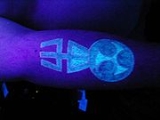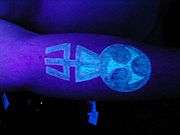
UV tattoo
Encyclopedia

Ultraviolet
Ultraviolet light is electromagnetic radiation with a wavelength shorter than that of visible light, but longer than X-rays, in the range 10 nm to 400 nm, and energies from 3 eV to 124 eV...
tattoos or blacklight
Black light
A black light, also referred to as a UV light, ultraviolet light, or Wood's lamp, is a lamp that emits ultraviolet radiation in the long-wave range, and little visible light...
tattoos are tattoos made with a special ink that is visible under an ultraviolet light (blacklight
Ultraviolet
Ultraviolet light is electromagnetic radiation with a wavelength shorter than that of visible light, but longer than X-rays, in the range 10 nm to 400 nm, and energies from 3 eV to 124 eV...
). Depending upon the ink, they can be nearly invisible in non-UV environments, thus they are a popular consideration for people seeking a subtler tattoo. They are particularly popular in the raver
Raver
Raver or ravers may refer to:* Raver, Maharashtra, a city in India* Raver, a party-goer: in the 1960s and 1970s, a "party animal"; since the 1980s, more specifically an aficionado of raves...
subculture.
Although the tattoos are sometimes considered invisible in normal light, scarring from the tattoo machine in the application process may remain, and therefore still show. A UV tattoo becomes visible under blacklight, when it glows in colors ranging from white to purple, depending on the ink chosen. Colored ink is also available, where the ink is visible in normal light (as with a regular tattoo) but the ink will glow vividly under UV light. However, some UV inks are not as bright under normal light as normal tattoo ink and are considered not as vibrant.
Arguments against UV tattoos
No tattoo inks have ever been approved by the United States Food and Drug Administration because the FDA "has not traditionally regulated tattoo inks or the pigments used in them". Claims made that UV Tattoo Ink is "FDA Approved" when used for tattooing appear to be fraudulent; some UV-reactive tattoo inks may have been approved by the FDA for food-related purposes (such as marking food animals, like fish), but this is not the same as being "FDA approved" for use on humans for cosmetic purposes.UV Tattoo Ink is also many times more expensive than regular tattoo inks. Some people have had reactions to ingredients in the ink, ranging from minor itching to dermatitis
Dermatitis
-Etymology:Dermatitis derives from Greek derma "skin" + -itis "inflammation" and genetic disorder.-Terminology:There are several different types of dermatitis. The different kinds usually have in common an allergic reaction to specific allergens. The term may describe eczema, which is also called...
. Several UV inks are suspected carcinogens and allergens and at this time no research has been conducted into the side effects of long term exposure. Although many people who have received UV or blacklight tattoos have had physical effects on the skin, any ink could cause a reaction. This can be a result of not protecting the tattoo from UV rays within 3 months of receiving the tattoo process or by using scented cremes or lotions on the tattoo area. This can damage the ink, causing it to become a normal ink color in all light. In time, it may also not glow in black lighting. Clear/blue UV inks are known to yellow or turn slightly brown with sun exposure. Color/black UV inks are known to become colored in all lighting. Therefore, it might permanently appear as a regular tattoo.
Arguments for UV tattoos
Over recent years, as the formulas for UV inks have been improved upon, it has become more common to hear reports of success with little or no reaction.Tattoos can be mostly invisible, suitable for those who may be restricted in their choice of tattoo placement (because of their profession, for example) who can then choose to show off the tattoo under UV or Black light lighting.
Application issues
UV inks are not as bright under normal light as normal tattoo inks, and do not blend during application, as normal inks do. Their effect will be dulled if regular ink is used on top of them. Therefore, for vibrant, high impact tattoos, normal ink is normally used, allowed to heal, and then highlighted with UV inks. Only highly experienced tattooists should apply UV tattoos, and should have a blacklight within arm's length of the tattoo chair. When applying white or clear UV ink, this blacklight should be turned on throughout the procedure.UV inking takes a little bit longer than normal, due to UV inks being a little thinner and harder to work with, and because the tattoo must be wiped and checked under a blacklight frequently during application.
Also note that for non-colour based UV work, it is possible that outlines can become an issue. If the artist isn't careful, any ink or other materials they use to outline their design can become part of the work. This is not normally an issue with standard tattoos as normal coloured ink covers this. However for fully hidden UV art, this can be a problem, as it will most likely not be even, or well distributed within the work, and reveal some of the art instead of being mostly hidden (scarring can always give away the art).

